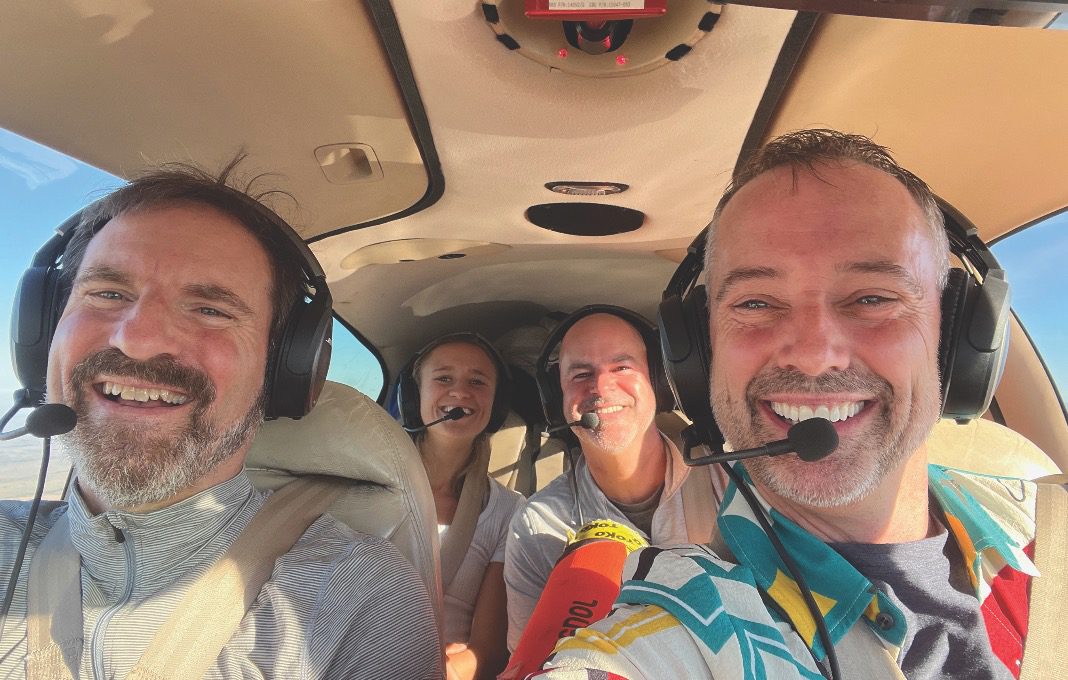The Pros Of Piloting


If private aviation is convenient for business chiefs, then flying their own planes is even more so. CEOs and company owners who double as pilots cite flexibility, control and even cost efficiency as benefits.
But that doesn’t mean the decision to purchase and operate their own planes is entirely a plus for the pilot-chiefs who do it. “You have to realize that when you’re flying an airplane, you’re actually working in that profession, so you don’t have the ability to sit back and pull up your emails the way other CEOs do when they’re flying,” says Tom Paquin, a pilot and CEO of Victory Base, a Dallas, Fort Worth-based housing company for military families. “It can be a distractor in a way if your intent is to be efficient on the plane itself.”
Indeed, all flying chiefs have a person- al calculus for whether it makes sense to them to fly or be flown commercially or in another private plane. Those operating in the Midwest are some of the biggest fans of piloting their own aircraft. There are about 20,000 airfields across the U.S., and most aren’t located in major cities. Having their own planes stashed in a small, exurban airports is particularly helpful when a CEO’s destination is another out-of-the-way place or a major city underserved by commercial airlines.
Brad Pierce’s situation is tailor-made for piloting the four-year-old, neon-green Cirrus SR22 he purchased in 2021. He’s CEO of Restaurant Equipment World, a third-generation, family-owned outfit that builds out restaurant kitchens and focuses on the military-base market. That means Pierce must make frequent trips to remote locations across America often served only by a small airport.
“I did a double transcontinental, flying between Orlando and South Dakota with a bunch of stops, events, customers, totaling 22 cities in 14 states over 12 days recently,” says Pierce, who began flying in college and once crash-landed a plane on Interstate 90 in New Orleans. “I’m in as many as four states in one day on a regular basis. It’s just a normal part of my day.”
Flying his Cirrus at cruising speeds of about 200 mph allowed Pierce to pile up all sorts of business wins. “I was in Chicago one day, flew to Ohio to meet with a customer, then was able to fly to Colorado and made it there for dinnertime by five minutes,” he recalls. “I traveled 800 miles that day. But it was a million-dollar event because literally stopping in and having that responsiveness turned into $1 million for our company. So, I couldn’t afford not to fly.”
Cheyenne II owner Bob Arnot feels the same way, and he lives in Stowe, Vermont, just 200 miles from Boston and a northern tip of the Eastern Seaboard megalopolis. “If I were living in New York, I’d have to get a car to Teterboro [an airport in New Jersey], wait an hour for clearance and then 45 minutes more before takeoff,” says the former medical correspondent for NBC News, who is now a technology consultant. “So, I’m already two hours and 45 minutes into the trip before takeoff. But in Stowe, I drive 15 minutes to the airport, and I get in the hangar, and 20 minutes after leaving home, I’m in the air.”
Keith Lauver is a serial entrepreneur—his latest startup, Space Monkey Partners, is a marketing consultancy that lists him as “Mission Controller”—who lives and flies out of southern Montana in a 21-year-old Cirrus. “I live in a very rural state, and connecting anywhere else in the country generally requires two or more flights,” he says. “Plus, I’ve got a customer in Missoula, normally a five-and-a- half- hour drive—but a one-and-a-half-hour flight. I can see the customer in the morning and spend the day and fly back and still be home in time for dinner.”
There’s also the cool factor. “I can take the customer and his wife up for a tour of the mountains of Glacier National Park,” Lauver says. “It’s a way to build a relationship outside of the typical customer relationship, to establish trust in a different way and to show a level of responsiveness.”
Here are some of the factors that go into decision-making by business chiefs who pilot their planes:
Opportunity costs. Pierce says it costs about $600 an hour to operate his $1 million airplane, including hangar rental and insurance. “But I couldn’t afford not to fly,” he says. “The amount of revenue it generates is the most affordable asset in my toolbox.”
Operating nearly any private airplane is more costly than the least-expensive business-travel alternative of paying for a coach seat on a commercial airline, but flying chiefs take a holistic approach to the cost equation. “The cost savings is not having a hotel at either end of the visit, and Cheyennes are reasonably inexpensive to run,” says Arnot, who typically flies his Cheyenne around the East Coast for his work.
The rule of thumb for Sargento Foods CFO Jeremy Behler is that piloting his Cirrus SR22 is worthwhile for a business trip if it cuts the time consumed by about two- thirds or more from the packaged-cheese company’s headquarters in Plymouth, Wisconsin, about 50 miles north of Milwaukee. When his destination is Indianapolis—where he also has relatives—Behler flies his single-engine four-seater. The car trip requires about five and a half hours, but he can get to Indy behind his joystick in only an hour and a half.
“Flying commercially would take a lot longer because there are no direct flights,” says Behler. “I’m the only one with access to my hangar at the Sheboygan [Wisconsin] Airport. I can check my plane the night before, do an abbreviated preflight check in the morning, and I’m off.”
The issue of control. David MacNeil loves “having a corporate jet available in times of crisis.” The founder and CEO of WeatherTech can fly any of the Bolingbrook, Illinois–based company’s fleet of two jets and four helicopters.
A need for focus. “If you fly for business, you have to enjoy it, because if you’re going to be a pilot, that’s adding another job,” Paquin says. “If you can actually fly the plane, that increases your stress level. You have to check the weather, all the [airport] approaches and all the other stressors that it takes to be a pilot—which you don’t do every single day.”
Behler says that when he’s piloting, “I’m singularly focused on flying, planning, communications with air-traffic control.” Yet, he notes, flying “helps out in a professional sense because the same discipline you put into training, being current and [mastering] the processes that keep you safe and legal and flying also apply to the professional world.”
Altruistic flying. Many piloting business chiefs like the fact that they’ve got the wherewithal and the piloting skills to perform significant altruism. For example, in 2019, Robert Arkin, CEO of Arkin Group, a Miami Beach, Florida-based construction firm, and a pilot, personally flew his six-seat Cherokee Six more than 54 flight hours back and forth to the Bahamas with relief supplies to help islanders deal with the aftermath of Hurricane Dorian.
Pierce frequently flies disaster-relief flights after hurricanes in the southeastern U.S. and Caribbean. “I’m one of the first people on the ground,” he says. “My staff knows that I disappear when hurricanes hit.”
Stormy weather. Pierce avers that “no customer is worth dying for” but stresses, “with my experience level, weather almost never stops me. Only if the airlines are canceling, I’m canceling.”
Pilot sensibilities often clash with business exigencies. “If you’re the go/no-go decision-maker as the pilot in command and there is a financial consequence of not making it from one place to another, you might not be in the best place to make a decision about weather, the aircraft and your qualifications as a pilot,” says Randy Reep, a Jacksonville, Florida-based law-practice owner, former Delta Airlines pilot and active flyer who still throttles F-15s as a member of the Florida Air National Guard. “Many experienced and sophisticated pilots—not just JFK Jr.—have made that mistake.” In fact, on July 16, 1999, Arnot was able to land his Cheyenne on Nantucket Island, Massachusetts, amid a brewing storm, not long before John F. Kennedy Jr. attempted to traverse to nearby Martha’s Vineyard from an airport in New Jersey in his Piper Saratoga—which tragically went down carrying him, his wife and his sister-in-law.
Though he flew in F-15s and F-16s as a reporter in Iraq and was embedded with a U.S. helicopter regiment, Arnot came closest to disaster flying his own plane. “I had a real trial flying over Lake Michigan to the airport in Iron Mountain, Michigan,” he says. “But the training is so good that your heart rate doesn’t even go up.”
Hedging against disaster is why some flying chiefs prefer a Cirrus, a plane that includes a parachute integrated with the airframe that can put the aircraft down safely in the case of many emergencies. Made in Duluth, Minnesota, the planes were invented 40 years ago by Dale and Alan Klapmeier after they walked away from a midair collision.
Do underlings come along? Part of the appeal for flying CEOs is to be able to ferry colleagues, saving money and promoting “together time.” Production managers and installers for Restaurant Equipment World, for instance, frequently accompany Pierce on his five-seater.
Others, however, frown on that sort of thing from a basic risk-management perspective. “If it’s a work trip,” Behler says, “I go by myself.”
Dan Muller was a frequent passenger on the Twin Cherokee flown by his boss, the late William Sharp Jr., founder of Advanced Research Co. in Orion Township, Michigan. Muller was the engineering manager, and Sharp “had no hesitation at all about also bringing the software-development manager on the plane with us. If the plane had gone down, the company would have shut down the next day.”
Such decisions carry “a very practical dimension,” says Lauver. “I make sure my life insurance premium is paid and my will is current.”


0

1:00 - 5:00 pm
Over 70% of Executives Surveyed Agree: Many Strategic Planning Efforts Lack Systematic Approach Tips for Enhancing Your Strategic Planning Process
Executives expressed frustration with their current strategic planning process. Issues include:
Steve Rutan and Denise Harrison have put together an afternoon workshop that will provide the tools you need to address these concerns. They have worked with hundreds of executives to develop a systematic approach that will enable your team to make better decisions during strategic planning. Steve and Denise will walk you through exercises for prioritizing your lists and steps that will reset and reinvigorate your process. This will be a hands-on workshop that will enable you to think about your business as you use the tools that are being presented. If you are ready for a Strategic Planning tune-up, select this workshop in your registration form. The additional fee of $695 will be added to your total.

2:00 - 5:00 pm
Female leaders face the same issues all leaders do, but they often face additional challenges too. In this peer session, we will facilitate a discussion of best practices and how to overcome common barriers to help women leaders be more effective within and outside their organizations.
Limited space available.

10:30 - 5:00 pm
General’s Retreat at Hermitage Golf Course
Sponsored by UBS
General’s Retreat, built in 1986 with architect Gary Roger Baird, has been voted the “Best Golf Course in Nashville” and is a “must play” when visiting the Nashville, Tennessee area. With the beautiful setting along the Cumberland River, golfers of all capabilities will thoroughly enjoy the golf, scenery and hospitality.
The golf outing fee includes transportation to and from the hotel, greens/cart fees, use of practice facilities, and boxed lunch. The bus will leave the hotel at 10:30 am for a noon shotgun start and return to the hotel after the cocktail reception following the completion of the round.